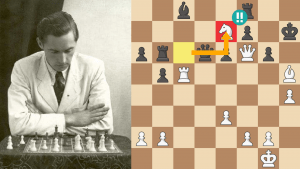
What Is The Initiative?
The Chess.com member Mornarben wrote: “My question is about the initiative. I seem to be able to play well in the beginning, getting positions with good central control, but [I] never see a good way to launch an attack to seize the initiative. I end up defending, even when I have the opening advantage. How do I seize the initiative when I get to the middlegame?”
Jeremy Silman: Mornarben, an initiative isn’t necessarily an attack. It just means that you are calling the shots and your opponent has to respond. Sometimes one side has a material advantage while the other has an initiative. The initiative might prove more valuable than your opponent’s material plus, but sometimes the side with the extra material might be able to end your initiative. That often means you’re toast since the initiative you had is gone while your opponent’s material advantage is still staring you right in the eye.

Stop your staring, material advantage!
A similar case occurs when one side has a superior pawn structure (a static plus) while the opponent has an initiative (a dynamic plus). It’s anyone’s game, and the result often favors the player who is aware of this battle and makes use of his plus.
In other cases, you can transform your initiative (usually temporary) into a long-term, static advantage.
For example, in your game against GBCCK (rated 1135), you had a clear advantage in development. Since your opponent will eventually catch up in development, you must...
- attack and try to drag him down right away or...
- make use of your development to gain some sort of long -erm plus like an extra pawn or a spatial advantage.
See if you can finish Black off!
White started out with a lead in development (a dynamic plus). White then played d2-d4 acquiring more central space (a static advantage). When the position opened with e4-e5, Black’s undeveloped army was unable to stop a rout.
Here’s another example of material versus an initiative:
Black is a pawn up, but White owns the e-file. White’s bishop is taking aim at the f7-pawn, and thanks to the pin along the a2-g8 diagonal, Qxg6+ is threatened. White is betting the initiative (dynamic) will offer enough compensation for Black’s extra pawn (static).
In this case, the only player that can win is Black. Black will simply tighten up the weak points and then, once everything is safe and sound and White’s initiative has been snuffed out, leave White in a purely defensive mode.
 Hurry ,or poof, your initiative will soon die out.
Hurry ,or poof, your initiative will soon die out.
Here’s a more advanced example where White’s initiative has little to do with attack and everything to do with creating long-term weaknesses in the enemy camp:
White’s goal is clear: put lots of heat on d6 until the pawn is forced to move to d5. White’s knight would then “win” the c5-square. Meanwhile, Black’s light-squared bishop is, for the moment, a tall pawn. Another way to talk about this is that White wants to make his knight better than Black’s bishops. By forcing ...d6-d5, that goal will become a reality.
As we saw, an initiative gives you an extra step in whatever position you have. However, one has to ask what the opponent has. If you have an initiative and your opponent doesn’t really have anything special, then you are in control of the game. Whether or not your control will bear fruit is another matter. In many cases, you’ll see one side with an initiative and another with various positional advantages or even extra material.
Which one wins? That depends on the particular position.
It is also very common for the initiative to morph into something else. It could become a full-fledged attack, or the initiative might turn into some kind of static plus such as a better pawn structure, more space, or a superior minor piece.






